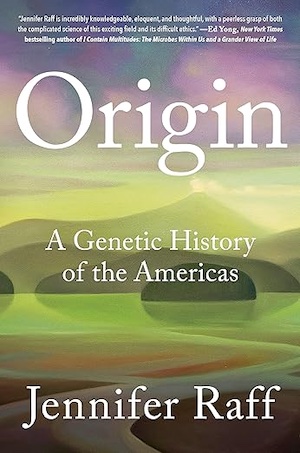Winner of the 2023 ΦΒΚ Book Award in Science
By Andrea K. Dobson
The stories of human migrations are inherently fascinating, arguably none more so than that of the peopling of the Americas. Who were the first peoples to enter these new and unexplored continents? Where did they come from? How many thousands of years ago did they arrive? What routes were open to them? How did they navigate the ice sheets that covered much of the northern reaches of the globe during the last glacial maximum? In Origin, Jennifer Raff, associate professor of anthropology at the University of Kansas, tells the intertwined stories of our current scientific understanding of the first Americans, the history of how we got to that understanding, and how recent advances in archaeology and paleogenetics push us to refine our picture of the earliest humans in the Americas.
Raff immediately confronts the fact that, in the quest to understand the first Americans, modern Indigenous communities have too often been treated disrespectfully. Often, but not always: Raff bookends her work with two illuminating stories. The nearly complete skeleton of Kennewick Man, or Oid-p’ma Natitayt (the Ancient One) as the Umatilla call him, eroded out of the bank of the Columbia River in Kennewick, Washington, in 1996. Two decades of contentious debate ensued. Radiocarbon dating of a bone fragment indicated that he died approximately 9,000 years ago. Was he related to modern Indigenous groups in the area? Who had the right to say what should happen to his remains? How can we, today, respect both the desire to learn about life in the region millennia ago and the values and traditions of Indigenous peoples of the Pacific Northwest to whom he could be related? Raff also describes a more collaborative study. Earlier the same month, in July 1996, human remains a thousand years older were also uncovered, this time in Shuká Káa (Man Ahead of Us) cave on Prince of Wales Island in southern Alaska. In this case leaders of the nearby Tlingit communities were rapidly consulted; they agreed that the site should be studied. Funded internships permitted several tribal citizens to participate in the excavations, and knowledge gained was shared with the local communities. Ultimately, the remains of both of these individuals were reburied according to the traditions of the tribes in the regions.
Collaboration informs Raff’s own research in anthropological genetics. Across several chapters she takes us inside the lab, describing the process by which genetic samples from ancient teeth and bones are extracted for analysis, as well as describing what we’ve learned from genomes of ancient Americans and what is still unclear. Ancient DNA is likely to have been degraded by exposure to the elements or contaminated by DNA from more recent sources, but technological advances have made it possible to amplify, sequence, and analyze these fragile samples much more reliably than just a few years ago. Raff takes pains to value the individual persons whose DNA she is working with, and not to regard their remains as merely lab samples. She also takes pains to consult with modern Indigenous communities for whom her research—the origin stories she is constructing—matters, particularly people who may be descendants of the person (or of others in the community of the person) whose remains Raff is studying.
Much is still to be explained in the history of the peopling of the Americas; much is, literally, underwater, submerged like the Bering land bridge by the rising sea levels as the glaciers started melting away roughly 20,000 years ago. It does seem most probable that, when dry land was available, people migrated eastward from Siberia and East Asia, entering the Americas by way of Alaska. Genetic and archaeological evidence admits several models for when, and for “what then?” The archaeological and genetic evidence points to people making their way well into South America fairly rapidly. Raff favors a model in which the first people reached Alaska roughly 18,000–20,000 years ago, people whose descendants likely then traveled by boat, following the “kelp highway,” down the west coast.
As Raff points out, the story she has told is one without an ending, as ongoing research continues to add new details. Still, Origin presents a valuable snapshot of the current state of our knowledge. Raff integrates ethnography and Indigenous traditions with linguistics, archaeology, and genetics, grounded in the historical complexity that has led to our current understanding, and she prepares us well to appreciate future developments in our picture of the peopling of the Americas.
Andrea K. Dobson (ΦΒΚ, Whitman College) is chair of the Astronomy Department at Whitman College.




